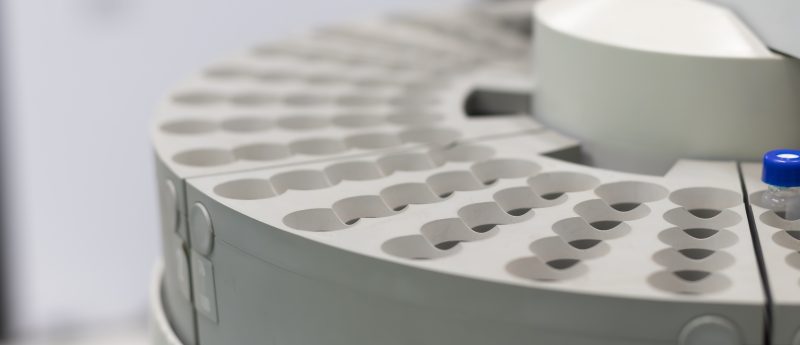Interview with Bonnie Alden (Waters Corporation) on the CORTECS columns

Refer a colleague
 Bonnie A Alden is a Senior Scientist within the Consumables Business Unit located at Waters Corporate Headquarters in Milford (MA, USA). She joined Waters Corporation in May of 1982, and was a member of the team that developed the Sep-Pak Classic and normal-phase sample preparation cartridges. In 1994, she joined the development team that brought Symmetry bonded phases to market. These phases defined batch-to-batch reproducibility at that time and still do today. Later she was fundamental to the launch of XBridge and XSelect HPLC Columns and the UPLC HSS T3 Column. Her most recent contribution to the family of Waters Columns has been in supporting the development of CORTECS Solid-Core Particle Columns.
Bonnie A Alden is a Senior Scientist within the Consumables Business Unit located at Waters Corporate Headquarters in Milford (MA, USA). She joined Waters Corporation in May of 1982, and was a member of the team that developed the Sep-Pak Classic and normal-phase sample preparation cartridges. In 1994, she joined the development team that brought Symmetry bonded phases to market. These phases defined batch-to-batch reproducibility at that time and still do today. Later she was fundamental to the launch of XBridge and XSelect HPLC Columns and the UPLC HSS T3 Column. Her most recent contribution to the family of Waters Columns has been in supporting the development of CORTECS Solid-Core Particle Columns.
Could you tell Bioanalysis Zone a little about your role at Waters Corporation and your work on the CORTECS columns?
I am a senior scientist in the Technology Advancement Group, and my main focus is the development and evaluation of prototype chromatographic bonded phases for small and large molecules. My group and I, along with synthetic chemists in R&D, form teams whose sole purpose is to develop new phases and understand their basic characteristics. Sometimes we focus on a narrow application area, like peptide analysis, and other times we focus on a particular chromatographic problem, like poor peak shape for basic, small molecules in formic acid mobile phases. It’s a pretty iterative process, and for some development projects, dozens of phases might be prepared and evaluated. We are also responsible for transferring the final product to the manufacturing facility, developing the Quality Control procedures and training the lab personnel. We work closely with Product Managers to make sure that we are developing products that meet the user’s needs and provide them with an application solution.
I’ve been evaluating bonded phases for over 25 years and have experienced the advancements that have led to the development of CORTECS solid-core columns. When I was first evaluating bonded phases, the typical column was 4.6 × 150 mm and was packed with 5 µm particles. I watched the trend to utilize smaller particle sizes to achieve higher efficiency, and was also aware of the higher backpressures that went along with that higher efficiency. Often my systems would shut down with high pressure failures. When sub 3-µm phases based on a silica solid-core were introduced, one of their remarkable features was lower backpressures than fully porous particles of similar particle size. This attribute alone merited an investigation into solid-core technology, and some of my initial involvement with CORTECS columns was actually as an evaluator of some of the very first prototype solid-core materials, as well as evaluating claims of already launched products. It was a pretty extensive research project and we wanted to provide the user with an enabling product. As the material’s capabilities became more defined, I worked with the Product Manager, Michelle Teuscher, to launch the product. It was a pretty amazing experience to coordinate the technical aspects of the project with the commercialization.
Could you briefly describe the CORTECS columns and tell us a little about what led to their development?
We’ve always desired to create new tools that enable higher performance, and these columns do just that. They are the latest addition to our family of different particle technologies. Unlike the BEH, HSS and CSH, which are fully porous particle technologies, CORTECS is solid-core technology. As the name implies, there is a non-porous solid-core of silica in the center of the particle that is surrounded by an outer layer of porous silica, where the chromatographic separation takes place. Solid-core particles have lower pore volume, and lower surface area than fully porous particles, and you would expect that the retention would be lower, but that’s not the case. The calculated phase ratios for the two types of material are similar, 136 m2/cm3 for the CORTECS UPLC particle and 124 m2/cm3 for the ACQUITY BEH particle, so the retention factors are equivalent.
As I’ve mentioned, I have been evaluating chromatographic materials for a long time and the one constant that I’ve seen is that we are always trying to achieve higher performance. That’s what drives product innovation. One great example of this has been the development of sub 2-µm phases to use on low dispersion UPLC instrumentation that have pressure limits of 15,000 psi. I’ve mentioned the low backpressures observed and reported for the sub 3-µm phases silica solid-core materials. We wanted to investigate this technology on sub 2-µm particles to achieve higher efficiencies and lower backpressures, without reducing particle size significantly.
How do the CORTECS columns differ from your other available columns?
Each of our particle technologies was developed for a specific purpose or to really excel in one area, so each is a unique and useful tool. For example, BEH Technology was designed for use over a wide pH and temperature range, and the CSH technology was designed for selectivity and use at low pH. CORTECS columns were designed to give maximum efficiency. They are a high performance column and will have the narrowest peak widths and highest resolution. With the backpressure benefit that CORTECS solid-core columns offer, the analyst has the option of operating at higher flow rates, increasing throughput or productivity.
What benefits do you feel researchers could gain from using the CORTECS columns in their work?
CORTECS columns are available in two particle sizes, 1.6 and 2.7 µm, a scalable platform, which is really important. That means that the analyst can quickly develop methods on either an HPLC system or UPLC system, and transfer them back and forth. Both particle sizes are known for producing columns with higher efficiencies than fully porous materials of comparable size, and the 1.6 µm columns have the highest efficiencies on the market. Narrow peaks not only increase the resolution of peak pairs, but they allow for lower amounts to be detected, so greater sensitivity is possible. This really fits in well with the bioanalysis market where the samples are going to smaller and smaller volumes.
The 2.7 µm particles were designed for use on traditional HPLC systems, where the operating backpressures are low. The 2.7 µm columns have 25% lower backpressure than competitive 2.6µm solid-core columns, so longer column lengths, up to 150 mm, can be used to improve resolution on HPLC systems for samples with many peaks. Often bioanalysis or clinical research labs may desire faster analyses to increase the number of samples per day. In this case, shorter length columns can be used. The lower backpressure, coupled with the fact that the columns are high efficiency, make them ideal for this type of operation.
These columns are also rugged. Biological samples are often taken from matrices that are complex, as well as variable. The sample preparation techniques used may be simpler, generic methods like protein precipitation or just sample dilution. The lower backpressures of CORTECS columns tend to make them more forgiving to non-ideal sample preparation techniques.
CORTECS columns were developed as general purpose columns for the analysis of small molecules, which means that they are suited for use in a variety of application areas. The traditional C18 chemistry is really a necessary column to have in any lab, but we also have a complementary selectivity option with C18+. This particle has an innovative surface modification for great peak shape of basic small molecules analyzed using formic acid mobile phases, which makes it an ideal column for MS applications.
Are there any potential concerns relating to method transfer with CORTECS columns?
I’ve heard the term ‘method transfer’ used for many different situations. I’ll address a few.
One of the simpler situations is merely transferring a method to a different laboratory, either down the hall or in a different facility. Since Waters Corporation is a primary manufacturer of chromatographic bonded phases, I really don’t have any concerns with the columns in this type of situation. We have complete control over the entire process, from particle synthesis to final column packing. The end result is a reproducible supply of columns across particle sizes and dimensions.
A second situation pertains to transferring a method from a CORTECS 2.7 µm column operated on an HPLC to a CORTECS 1.6 µm column operated on a UPLC. Correct scaling and matching the L-dp ratio will result in equivalent chromatography. My biggest ‘watch-out’ would be to consider the system delay volume if you are transferring a gradient. HPLC systems with low pressure mixing may have higher delay volumes than UPLC systems, so retention times may be affected.
A third situation involves transferring a method to a CORTECS column that has been developed on a different bonded phase. There are hundreds of C18 bonded phases available. A separation transferred to a CORTECS column may not produce exactly the same chromatography as the original method. Base particle attributes like surface area, pore volume and bonding coverage all influence your analytes retention, so you may need to adjust your conditions accordingly.
Please enter your username and password below, if you are not yet a member of Bioanalysis Zone remember you can register for free.






